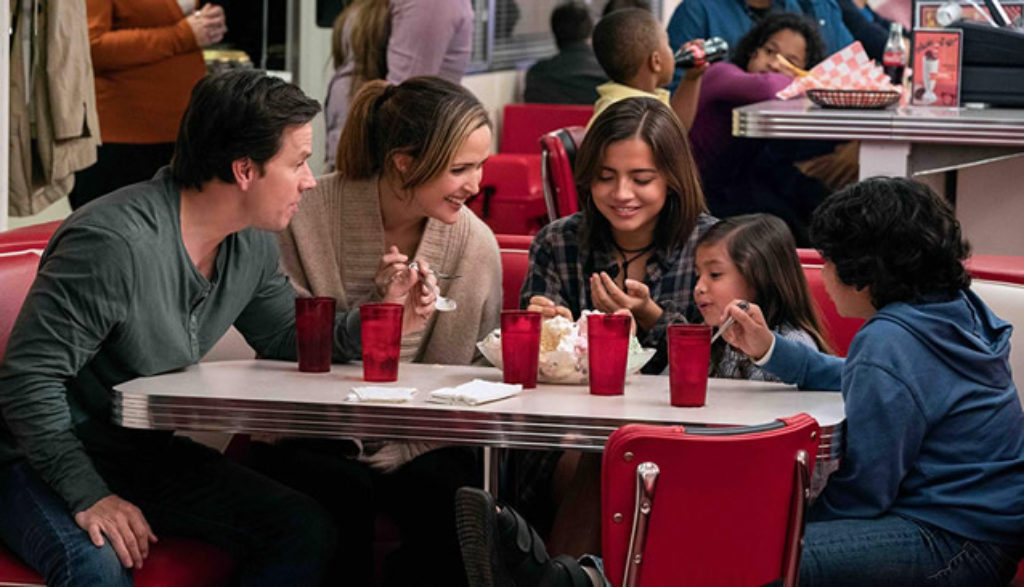
“What are they going to do with five bedrooms?” Russ asks his wife, Kim. “You guys are obviously never having kids.”
That assessment catches Pete and Ellie off guard. After all, the fortysomething couple enjoys flipping houses. They’re good at it. They make good money. They live uncomplicated lives—in contrast to Russ and Ellie’s sister, Kim, whose existence is defined by snot-smeared, kid-shaped chaos.
But Russ’ observation especially touches a nerve with Ellie. Yes, it’s too late to have kids of their own. But … what about adoption? What about foster care?
Pete’s resistant … for about a minute. Then he sneaks a look at a foster care website Ellie’s been perusing. Soon he’s crying right along with her.
How could they not consider this path toward parenthood. I mean, how much different could raising foster kids be than, say, remodeling an old house, right? Both involve taking something broken and fixing it, right? And just like that, Pete’s all-in, 100%.
Pete and Ellie plunge into in an eight-week foster care certification course, taught by two conscientious experts named Karen and Sharon. Others in the class include an infertile Christian couple (“The Lord guided us here to adopt a baby boy or girl,” the wife says), two men in a same-sex relationship (who’ll take a “child of any gender”) and an athletic single woman who wants a big African-American boy with NFL potential (she’s a fan of the The Blind Side).
Pete and Ellie learn some sobering facts: More than half a million kids in the foster care system are awaiting forever families. Many come from homes ravaged by parental drug use and violence, neglect and abandonment, physical and sexual abuse. Teens in foster care are especially at risk: More than half of the adolescents who “age out” of the system end up “homeless, addicted, incarcerated or dead within two years,” says one of the leaders.
At the end of the course, Pete, Ellie and the other participants meet children who are awaiting families. Pete suggests they talk to some teens, whom everyone else is avoiding.
Ellie’s not interested: “They use drugs. They masturbate. They watch people playing video games on YouTube.”
“Hi!” a perky teen girl chimes in. “Just FYI: We can all hear you.”
Turns out her name is Lizzy. She’s a feisty 15. And she’s got two younger siblings, Juan and Lita, whom she’s practically raised herself since they were all removed from their drug-addicted mother several years before.
Soon Pete and Ellie decide to take the plunge, inviting all three siblings into their home and committing to being the best foster parents they can be.
Everything goes great at first. This is easy, they think. They’re naturals, they brag to the other participants in the foster parent support group they’re in.
And they are. Right up to the moment it all falls apart.
Then things get real as Pete and Ellie learn first-hand that fostering three children with a rough past isn’t like remodeling an old house at all.
It’s infinitely harder.
But infinitely more meaningful.
Pete and Ellie have carved out a terrific life together. But when Kim jokes about them being childless, it uncovers a deep, unfulfilled desire in Ellie to be a mom.
Once they commit to become foster parents, Pete and Ellie do so with gusto. Though they didn’t plan on fostering three children, they take a deep breath and say yes.
It’s idyllic at first, tucking the kids in, saying goodnight, waiting for the kids to call them “Mom” and “Dad.” At their support group, a more experienced voice says, “It’s a honeymoon period.” Pete balks: “It doesn’t feel like a honeymoon period.”
But like all honeymoons, it doesn’t last. There are tantrums about food, spilt milk, injuries, broken dishes. And Lizzy? Well, the life she’s endured has shaped her into a young woman who’s whip-smart, manipulative, deceptive and brazen—a headstrong, worldly-wise 15-year-old who acts like she’s going on 30. Those character qualities lead to plenty of conflicts as Pete and Ellie keep on loving her despite some awful things she says and does.
Lizzy not only has huge trust issues, but she longs to be reunited with her birth mother, who’s just gotten out of prison and has been sober long enough for that to be a legal possibility. As the film moves forward, Pete and Ellie come to grips with the fact that all of the love, care and effort that they’ve invested could end with the children being reunited with their birth mother. As one of the foster care facilitators tells them, “Until the kids are adopted, the primary goal of the system is family preservation.”
At a low point, Pete and Ellie visit a foster couple who adopted a troubled teen and who spoke to their class about how well the teen did in their care. Turns out the girl has since relapsed into addiction, but they tell Pete and Ellie how important it is to keep loving foster kids even when they make poor choices.
One married couple in Pete and Ellie’s foster care class frequently peppers dialogue with Christian jargon like “the Lord” and “the Big Guy,” coming across as a shallow, two-dimensional stereotype of evangelical Christians. Someone wears a cross.
Karen, one of the women leading the foster care training program, also chimes in, “The Big Guy won’t give you any more than you can handle.” Her compatriot, Sharon, immediately retorts, “I beg to differ.”
Someone uses the phrase “manifesting to the universe.” Pete and Ellie talk about whether they have a “cosmic connection” with their foster kids.
The gay couple in the group, Kit and Michael, jokes about not being able to conceive, shortly after the Christian couple has made the same admission. There’s also a single woman in the foster care class, reinforcing the film’s inclusive message that anyone who wants to be a foster parent (or parents) should be able to do so. Still photos of real foster families in the credits reinforce this theme of diversity, showing several same-sex couples with a foster child.
Ellie suggests that she’s not interested in fostering a teen, in part because of the issue of sexual activity. And that’s an issue with Lizzy. She has a penchant for very revealing clothing (we see a lot of cleavage, midriff and leg). Pete finds thong underwear he thinks is his wife’s, and he’s horrified to learn that it’s Lizzy’s. Ellie catches Lizzy in the bathroom taking naked selfies to send to a guy at school. (We only hear Lizzy and Ellie’s mutually startled screams; nothing is shown.)
Ellie and Pete soon find what are repeatedly called “d–k pics” (and other cruder phrases are used, too) on Lizzy’s smartphone, sent by someone at Lizzy’s school who’s pressuring her to return the favor. Pete and Ellie are furious, crudely confronting the student whom Lizzy accuses of sending the pictures. But Pete and Ellie eventually figure out that the sender is not, in fact, one of Lizzy’s teen peers, but a hunky, creepy janitor. (More on this in Violent Content.)
We hear sarcastic quips about fertility, in vitro fertilization, and the quality of someone’s uterus. Pete and Ellie kiss (something that their foster children find endlessly fascinating, especially Lita). We hear passing references to a strip club, a sperm bank and masturbation.
When Pete and Ellie identify the janitor (who’s a young adult) who sent nude pictures to Lizzy, they chase and attack him. Pete decks him. Ellie kicks him the crotch. All three get arrested, Pete and Ellie for assault, the janitor for sexual charges related to a minor. (“Enjoy your life as a sex offender,” Pete yells.) The film depicts their violent response as wrong, but it also invites us to sympathize with parents who are fiercely trying to protect their foster daughter.
Juan, the middle child, is sensitive, timid and accident prone. While playing basketball with Pete, Juan gets clocked in the face hard. He breaks a glass and walks through it, cutting his foot. And while helping Pete do some remodeling work, he drops a nail gun on his foot and shoots a nail through it, prompting a trip to the ER (where Lizzy tries hard to make sure the accident doesn’t get the kids removed from Pete and Ellie’s care).
Pete realizes Lizzy has deep anger issues. So he takes her to the house they’re rehabbing to help him tear out a kitchen. She attacks the job with gusto … and with a sledgehammer, absolutely demolishing the house’s old kitchen accoutrements.
We hear, in general terms, that foster children often suffer physical and sexual abuse. We also see a flashback that shows an older dad playing with his son and having a heart attack (and apparently dying). We learn that Lizzy’s mom set their house on fire with a crack pipe. There’s a story about kids who threatened to slash the throats of their foster parents in the middle of the night.
One f-word, one incomplete pairing of that word with “mother” and three uses of “frickin’.” We also hear nearly 30 s-words, more than 20 misuses of God’s name (two paired with “d–n”) and four abuses of Jesus’ name. Other vulgarities include more than a dozen uses of “a–,” five uses each of “h—” and “p-ss,” and a handful of uses of “d–n,” “b–ch,” “crap,” “whore,” “suck,” “douche” and “fart.” Anatomical slang includes six or seven uses of “d-ck” and one reference to the band P—y Riot. We see a crude hand gesture as well.
In class, Pete and Ellie say that they’ll put their alcohol out of reach of the kids, which we see them do. Later, a very stressed out Ellie opens the cabinet to pour herself a drink. Adults drink beer and wine at a family gathering as well.
Pete and Ellie hear that their foster kids’ mother has been addicted to crack for years. As the movie progresses, the children learn that she’s been sober long enough for the court to consider reinstating her custody of them.
Lizzy, as mentioned, is at times deceptive and rebellious—character traits that Pete and Ellie strive to help her overcome. We see Ellie sitting on a toilet. (We see a bit of her legs.) Someone inadvertently compares having a foster child to getting a rescue dog from an animal shelter.
The single woman who wants to adopt a black child to be a pro athlete is mercilessly mocked for a her objectifying, borderline racist motivation for being a foster parent. (Though, it should be said, she doesn’t end up with a child like the one she wanted.)
Multiple people deride the motivations of “rich white people” who adopt foster children. We also hear about unscrupulous foster parents who use their kids as a “meal ticket” for governmental financial support.
Instant Family offers a poignant, comedic and at times profane portrait of the ups and downs of becoming foster parents. Unlike some Hollywood dramatizations of complex issues, this one rings true on many levels.
That’s likely because it was inspired by a real story. Screenwriter and director Sean Anders and his wife fostered, then adopted, three children themselves. Many of the anecdotes and events in the movie are, Anders said in a short interview before the film, based on things that really happened. Anders also said that he wanted to write a “seriously funny, heartfelt comedy that doesn’t pull any punches.”
Instant Family accomplishes that goal admirably in many ways. In fact, I’d say it’s the most pro-family film I’ve seen in years. This story does indeed “focus on the family,” showing how two loving, committed and sacrificial parents can change the trajectory for needy children in the foster care system.
Unfortunately, I have to add a “but” to that glowing description.
Two issues keep Instant Family from being a slam-dunk family friendly film. The first is the inclusion of a gay couple in the foster care preparation class. Many in mainstream culture have rendered a verdict on this controversial issue already, and they have embraced this possibility. But many convictional Christians and organizations, including Focus on the Family, still believe that a same-sex parental context is not the one that God has designed and intended for raising children.
The film doesn’t place a huge emphasis on this type of foster parenting situation; frankly, the stereotypical depiction of the same-sex couple here is often treated more as a vehicle for comic relief (ditto the Christian couple, I might add) than as a core element of the story. But the film’s inclusion of them (as well as the photos in the closing credits) still sends the message that same-sex foster care and adoption are just as normal and acceptable as any other arrangement, an assertion many Christians will disagree with.
The second, and more pervasive, problem is the profane language throughout this PG-13 comedy. Nearly a hundred vulgarities fill the script, including some very harsh ones and misuses of Jesus’ name.
So as terrific as this film’s central message is, those two concerns badly tarnish its appeal for many families who otherwise might have been inspired by its funny, moving and realistic portrait of becoming a foster family.
The Wait No More® program from Focus on the Family prepares hearts and homes for kids in foster care—whether for a season, or for a lifetime. Anyone who feels called to foster, adopt or support a foster/adoptive family can check out these resources for more information.
Website: Wait No More
Article: A Foster Care Story: My Journey of Faith
Video: Changing the World Through Adoption
Book: The Foster Journey: Often a winding road. Always a trip.


After serving as an associate editor at NavPress’ Discipleship Journal and consulting editor for Current Thoughts and Trends, Adam now oversees the editing and publishing of Plugged In’s reviews as the site’s director. He and his wife, Jennifer, have three children. In their free time, the Holzes enjoy playing games, a variety of musical instruments, swimming and … watching movies.